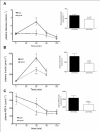Extremely short duration high intensity interval training substantially improves insulin action in young healthy males
- PMID: 19175906
- PMCID: PMC2640399
- DOI: 10.1186/1472-6823-9-3
Extremely short duration high intensity interval training substantially improves insulin action in young healthy males
Abstract
Background: Traditional high volume aerobic exercise training reduces cardiovascular and metabolic disease risk but involves a substantial time commitment. Extremely low volume high-intensity interval training (HIT) has recently been demonstrated to produce improvements to aerobic function, but it is unknown whether HIT has the capacity to improve insulin action and hence glycemic control.
Methods: Sixteen young men (age: 21 +/- 2 y; BMI: 23.7 +/- 3.1 kg x m-2; VO2peak: 48 +/- 9 ml x kg-1 x min-1) performed 2 weeks of supervised HIT comprising of a total of 15 min of exercise (6 sessions; 4-6 x 30-s cycle sprints per session). Aerobic performance (250-kJ self-paced cycling time trial), and glucose, insulin and NEFA responses to a 75-g oral glucose load (oral glucose tolerance test; OGTT) were determined before and after training.
Results: Following 2 weeks of HIT, the area under the plasma glucose, insulin and NEFA concentration-time curves were all reduced (12%, 37%, 26% respectively, all P < 0.001). Fasting plasma insulin and glucose concentrations remained unchanged, but there was a tendency for reduced fasting plasma NEFA concentrations post-training (pre: 350 +/- 36 v post: 290 +/- 39 micromol x l-1, P = 0.058). Insulin sensitivity, as measured by the Cederholm index, was improved by 23% (P < 0.01), while aerobic cycling performance improved by approximately 6% (P < 0.01).
Conclusion: The efficacy of a high intensity exercise protocol, involving only ~250 kcal of work each week, to substantially improve insulin action in young sedentary subjects is remarkable. This novel time-efficient training paradigm can be used as a strategy to reduce metabolic risk factors in young and middle aged sedentary populations who otherwise would not adhere to time consuming traditional aerobic exercise regimes.
Figures
Similar articles
-
Changes in aerobic capacity and glycaemic control in response to reduced-exertion high-intensity interval training (REHIT) are not different between sedentary men and women.Appl Physiol Nutr Metab. 2016 Nov;41(11):1117-1123. doi: 10.1139/apnm-2016-0253. Epub 2016 Jul 7. Appl Physiol Nutr Metab. 2016. PMID: 27753506
-
Towards the minimal amount of exercise for improving metabolic health: beneficial effects of reduced-exertion high-intensity interval training.Eur J Appl Physiol. 2012 Jul;112(7):2767-75. doi: 10.1007/s00421-011-2254-z. Epub 2011 Nov 29. Eur J Appl Physiol. 2012. PMID: 22124524
-
Functional high-intensity exercise training ameliorates insulin resistance and cardiometabolic risk factors in type 2 diabetes.Exp Physiol. 2018 Jul;103(7):985-994. doi: 10.1113/EP086844. Exp Physiol. 2018. PMID: 29766601 Free PMC article.
-
Low-volume high-intensity swim training is superior to high-volume low-intensity training in relation to insulin sensitivity and glucose control in inactive middle-aged women.Eur J Appl Physiol. 2016 Oct;116(10):1889-97. doi: 10.1007/s00421-016-3441-8. Epub 2016 Jul 29. Eur J Appl Physiol. 2016. PMID: 27473445 Clinical Trial.
-
Low-Volume High-Intensity Interval Training in a Gym Setting Improves Cardio-Metabolic and Psychological Health.PLoS One. 2015 Sep 24;10(9):e0139056. doi: 10.1371/journal.pone.0139056. eCollection 2015. PLoS One. 2015. PMID: 26402859 Free PMC article. Clinical Trial.
Cited by
-
GLUT4 localisation with the plasma membrane is unaffected by an increase in plasma free fatty acid availability.Lipids Health Dis. 2024 Apr 2;23(1):94. doi: 10.1186/s12944-024-02079-z. Lipids Health Dis. 2024. PMID: 38566151 Free PMC article.
-
Frontiers and hotspots of high-intensity interval exercise in children and adolescents: text mining and knowledge domain visualization.Front Physiol. 2024 Mar 6;15:1330578. doi: 10.3389/fphys.2024.1330578. eCollection 2024. Front Physiol. 2024. PMID: 38510943 Free PMC article. Review.
-
Effects of a 2-Week Kinect-Based Mixed-Reality Exercise Program on Prediabetes: A Pilot Trial during COVID-19.J Obes Metab Syndr. 2024 Mar 30;33(1):54-63. doi: 10.7570/jomes23040. Epub 2024 Jan 11. J Obes Metab Syndr. 2024. PMID: 38204191 Free PMC article.
-
Acute and adaptive cardiovascular and metabolic effects of passive heat therapy or high-intensity interval training in patients with severe lower-limb osteoarthritis.Physiol Rep. 2023 Jun;11(11):e15699. doi: 10.14814/phy2.15699. Physiol Rep. 2023. PMID: 37300374 Free PMC article.
-
Skeletal muscle mechanisms contributing to improved glycemic control following intense interval exercise and training.Sports Med Health Sci. 2023 Jan 25;5(1):20-28. doi: 10.1016/j.smhs.2023.01.002. eCollection 2023 Mar. Sports Med Health Sci. 2023. PMID: 36994179 Free PMC article. Review.
References
-
- Hickey MS, Weidner MD, Gavigan KE, Zheng D, Tyndall GL, Houmard JA. The insulin action-fiber type relationship in humans is muscle group specific. Am J Physiol. 1995;269:E150–154. - PubMed
LinkOut - more resources
Full Text Sources
Other Literature Sources
Miscellaneous


